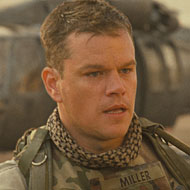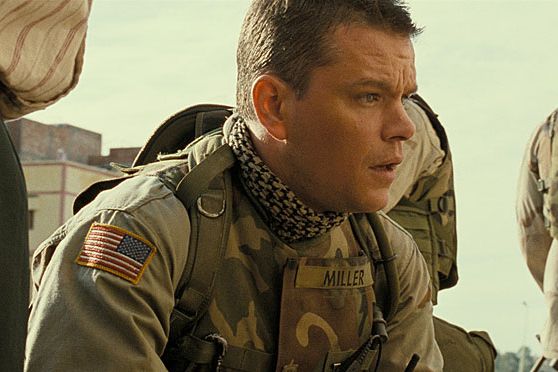“It’s one of the best things I’ve ever done,” Paul Greengrass says of the frenzied nine-minute action sequence at the heart of his Iraq thriller, Green Zone. That’s quite a statement, coming from the director of four much-imitated, quick-zooming, rapid-fire films — Bloody Sunday, The Bourne Supremacy, The Bourne Ultimatum, and United 93 — that revolutionized the way realistic action is shot. So here’s the setup: Matt Damon plays Miller, an officer whose WMD-hunting task force is pointlessly digging in a dirt soccer field. As the team digs, he interrogates a Baathist, and is on the verge of a breakthrough when rival Special Forces officer Briggs (Jason Isaacs) suddenly lands a helicopter, takes the prisoner, and beats down Miller. Watch the scene, and then follow the slideshow in this post as Greengrass explains the choices behind every shot.
A camera pans around a busy public square as a source tips off Miller to a Baathist meeting. “You want the location to make a visual statement — but not seem too contrived. We shot near Rabat, Morocco; it felt like Baghdad.”
Rapid-fire action sequence: Soldiers abduct a Baathist, then secure him amid a crowd of angry locals. “Is Matt going to be among actors playing soldiers? Or among soldiers playing soldiers? I wanted guys who served in Iraq.”
Alternating shots frame an improvised interrogation. “I tell actors, ‘Forget the script. Explore what this might feel like if you were doing it for real. You think this guy can help you get WMDs: What are you gonna do?’”
Close-up: The distraught prisoner offers up an important book. “[The actor] knows he’s among friends. But psychologically, if you’re tied up and thumped against a wall, by real soldiers, you’ll feel vulnerable. It just kicks you into a new gear. Look at his face: I feel his fear.”
Whip-pan to wide shot: A Special Forces team arrives to take Miller’s prisoner. “How does the helicopter enter in a dramatic way? You don’t want them to be seen from four miles off and everybody to be waiting. You want them just to be there: bang! We chose this location because of this unseen ravine: the helicopter just shoots up out of the ground.”
A handheld tracking shot follows Griggs as he storms past Miller. “It’s the first time they meet — the whole film turns on this encounter. But Griggs walks right past him, toward the prisoners. See, he’s literally ignoring him. The first day, the shot didn’t work. I didn’t know why. Then Jason [Isaacs] said, ‘I know what the problem is, I’m stopping to talk to him, and of course I wouldn’t. I’m only stopping to talk to him because I know in our story that I’m going to have a relationship with him all the way through to the end of the movie. In fact, what I should do is completely ignore him and walk straight past him because all I want is the prisoners.’ I said, ‘You’re absolutely right.’”
Jittery pans reflect the prisoners’ disorientation as they’re quickly abducted by the real-life vets in a by-the-book extraction. “You don’t rehearse this. Actors can’t create this body language. It’s complicated — bagging and zip-cuffing a guy.”
As the helicopter lands, the noise becomes deafening and the air is filled with dust, amplifying the confusion and tension. “For me, it’s screenplay, casting, location, and then tempo and intensity — that core stuff. People ask, ‘How do you do it? How do you get that sort of feeling that it’s very live and intense but also purposeful and clear?’ Well, when it works you’re working to bring those two contrary impulses of structure and freedom into alignment: There’s a clarity to the scene, a clarity to what the characters want, a clarity to the action. But it’s rendered in this very free, immediate, improvised style. So it’s neither one nor the other, so it’s the two yoked together. That’s where the intensity comes from.”
Griggs and Miller fight over the book. “When Isaacs hits Damon, it’s a bold moment; you expect Damon to deck him — it’s Matt Damon! But he’s bested. I like that he doesn’t have superpowers. He’s just a guy who gets bested and left with a bloody nose going, ‘What the fuck?’”
Close-up of Miller, mid-fight, handing off the book to his source. “He’s a movie star, so you expect him to turn around and deck the guy — so when he tries for a haymaker, you think, ‘All right!’ Then he misses and you realize he’s only doing it so he can hand off the book. This is straight storytelling: We require the hand-off of the book. I thought it gives you an interesting dynamic to the fight.”
Unlike many directors, Greengrass likes to edit his dailies as he’s shooting. “Get your shots. Stick them in the cutter very fast — the very next day if you can. This scene, we shot over about ten days. What you shoot on day one, you can revisit on day eight, but you have to know what you want. In your cutting room, work very, very fast. We’re trying to give it structural rigidity with what we’ve actually shot — so we know what we need. That way you can keep the bit in the middle, the performance, as free as possible.”
Griggs leaves. Quick zoom-in on Miller, who realizes his source has disappeared with the book. “Then it just keeps going. He chases [the source] down the alley. Always, I want to keep it moving: physically moving, morally moving.”






![Close-up: The distraught prisoner offers up an important book. “[The actor] knows he’s among friends. But psychologically, if you’re tied up and thumped against a wall, by real soldiers, you’ll feel vulnerable. It just kicks you into a new gear. Look at his face: I feel his fear.”](https://pyxis.nymag.com/v1/imgs/4b1/f62/515fd90252e3acfa43eb8cfe607efe5a8e-20100309-greenzone-4.rhorizontal.w700.jpg)

![A handheld tracking shot follows Griggs as he storms past Miller. “It’s the first time they meet — the whole film turns on this encounter. But Griggs walks right past him, toward the prisoners. See, he’s literally ignoring him. The first day, the shot didn't work. I didn't know why. Then Jason [Isaacs] said, 'I know what the problem is, I’m stopping to talk to him, and of course I wouldn’t. I’m only stopping to talk to him because I know in our story that I’m going to have a relationship with him all the way through to the end of the movie. In fact, what I should do is completely ignore him and walk straight past him because all I want is the prisoners.' I said, 'You’re absolutely right.'](https://pyxis.nymag.com/v1/imgs/072/e1b/7337289c0740d5eb611001f60c909eb758-20100309-greenzone-6.rhorizontal.w700.jpg)





![Griggs leaves. Quick zoom-in on Miller, who realizes his source has disappeared with the book. “Then it just keeps going. He chases [the source] down the alley. Always, I want to keep it moving: physically moving, morally moving.”](https://pyxis.nymag.com/v1/imgs/06b/709/7cf47b6fce08aa4b27a26ac4d98c5f917b-20100309-greenzone-12.rhorizontal.w700.jpg)